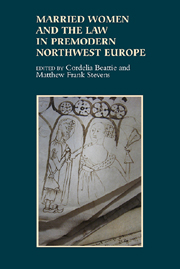Book contents
- Frontmatter
- Contents
- Figures and Tables
- Contributors
- Introduction: Uncovering Married Women
- 1 Inheritance, Property and Marriage in Medieval Norway
- 2 Spousal Disputes, the Marital Property System, and the Law in Later Medieval Sweden
- 3 When Two Worlds Collide: Marriage and the Law in Medieval Ireland
- 4 Married Women, Crime and the Courts in Late Medieval Wales
- 5 Peasant Women, Agency and Status in Mid-Thirteenth- to Late Fourteenth-Century England: Some Reconsiderations
- 6 London's Married Women, Debt Litigation and Coverture in the Court of Common Pleas
- 7 Married Women, Contracts and Coverture in Late Medieval England
- 8 Property, Family and Partnership: Married Women and Legal Capability in Late Medieval Ghent
- 9 ‘For His Interest’? Women, Debt and Coverture in Early Modern Scotland
- 10 The Worth of Married Women in the English Church Courts, c.1550–1730
- 11 Married Women, Work and the Law: Evidence from Early Modern Germany
- Index
7 - Married Women, Contracts and Coverture in Late Medieval England
Published online by Cambridge University Press: 05 July 2013
- Frontmatter
- Contents
- Figures and Tables
- Contributors
- Introduction: Uncovering Married Women
- 1 Inheritance, Property and Marriage in Medieval Norway
- 2 Spousal Disputes, the Marital Property System, and the Law in Later Medieval Sweden
- 3 When Two Worlds Collide: Marriage and the Law in Medieval Ireland
- 4 Married Women, Crime and the Courts in Late Medieval Wales
- 5 Peasant Women, Agency and Status in Mid-Thirteenth- to Late Fourteenth-Century England: Some Reconsiderations
- 6 London's Married Women, Debt Litigation and Coverture in the Court of Common Pleas
- 7 Married Women, Contracts and Coverture in Late Medieval England
- 8 Property, Family and Partnership: Married Women and Legal Capability in Late Medieval Ghent
- 9 ‘For His Interest’? Women, Debt and Coverture in Early Modern Scotland
- 10 The Worth of Married Women in the English Church Courts, c.1550–1730
- 11 Married Women, Work and the Law: Evidence from Early Modern Germany
- Index
Summary
It is a wyues ocupacyon … to go or ryde to the markette: to sell butter / chese / mylke / egges / chekens / capons / hennes / pyg-ges / gees / and all maner of cornes. And also to bye all maner of necessarie thynges / belonging to housholde: and to make a trewe rekenynge and accompt to her husbande / what she hath receyued and what she hath payed.
John Fitzherbert, Book of Husbandry (1523)Fitzherbert's picture of a woman buying and selling at market seems unremarkable. Craig Muldrew comments that, ‘In any print or painting of marketplaces in the early modern period, women are always present’, while Amy Erickson adds, ‘In all of the illustrations that I have seen women actually predominate in the market both as buyers and as sellers.’ But what if we imagine a situation in which the goods that a wife wants to buy cost more than the goods that she has sold? Would anyone extend credit to this married woman? If so, who would be liable for the debt if she did not honour it? Would it matter if she bought luxuries rather than necessities, or if the goods were for her own trade?
- Type
- Chapter
- Information
- Married Women and the Law in Premodern Northwest Europe , pp. 133 - 154Publisher: Boydell & BrewerPrint publication year: 2013



